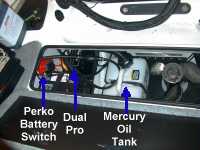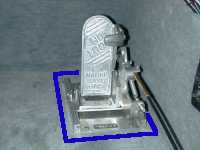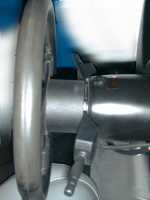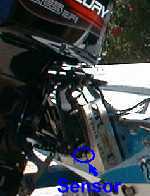
Rip's Tips - Rigging  |
Other tip pages: general comments | rigging | settling in | fixing stuff | gadgets | discussion
This particular tip page highlights some rigging experiences while setting up my '99 TR21...

above - battery compartment rigging |
Tip: Battery Compartment - During rigging, I
asked my dealer to share his and consider my
suggestions for mounting options.
We decided to place the large Mercury oil reserve on the starboard side of the metal floor plate. We decided to tuck the Charging Systems International Dual Pro charger behind the starting battery. This leaves room on the port side of the metal floor plate for the spare prop. Yes, that's a gallon of Amsoil synthetic TCW-3 injector oil next to the remote oil fill.
I have links to brand names like CSI on my other links page. |

above - adjustable plate option under Hot Foot throttle (Remember click on any photo for a larger view) |
Tip: Adjustable Foot Throttle - I decided to
put an adjustable plate option on the T-H
Marine Supply Inc. Hot Foot foot throttle.
Adjusting pedal position helps different sized family members or partners drive comfortably. The T-H Marine accessory (HFM-1 adjustable Hot Foot slide mount) can be seen under the foot throttle in the picture. The pedal assembly can be moved 5" on the plate. A pin of the left side holds it secure after adjustment. For those that get new boats every few years, adjustability can be a selling point to a buyer. A foot throttle is a great safety feature for a high performance boat.
I showed them how it returned the boat to an idle speed without foot pressure. I showed them how it freed my hands for driving. I told them how it really helped pace boat speed when driving in big waves or swells. Since mine is adjustable, we set it so his wife could try it. She was learning to drive. They decided this was much better for their boating activities. We discussed that it takes some "getting used to" time before docking or maneuvering in traffic or close quarters. Take some time to share with others. Where I work, what I just did would be called a method-demonstration, showing how something works by hands-on demonstration. My Extension agency is involved in adult and youth continuing education. |
| Tip: Perko Battery Switch - Mike Witt's
service tech, Mike VanNatta, suggested
placing my Perko battery switch on the wall
behind the starting battery. Great Location.
Why was the Perko battery switch such an important feature to me?
This common Perko product is available from Bass Pro Shops, other mail-order suppliers and most local marine dealers. |

above - battery switch on compartment wall above - how mine was wired... |

above - dual stem levers rigged for trim and jack plate |
Tip: Pro Trim Levers - I really like the feel of
the Triton option for steering column mounted
dual trim and jack plate height levers by
Teleflex. The single stem lever for trim is
standard.
During rigging, I asked my Triton dealer and his service tech to put OEM gauges for trim angle and jack-plate height into left/right cut outs above the column to match lever location. On my old boats, I've had jack-plate switches mounted on the dash or a trim switch on the shifter. I had one of those floor mounted jobs too. I like this Teleflex lever idea much better... eyes on the water. By talking with my dealer up front, my purchase price included installation of the second switch lever which involved pulling the steering wheel and routing wires, not hard but so much quicker if you know what you are doing like Mike VanNatta.
Teleflex's main web site (http://www.teleflex.com) lists product adaptability to certain regular or tilt steering systems. Nice compliment to the TR21's standard Teleflex's SeaStar hydraulic steering. |
| Tip: Surface Water Temperature Sensor -
My dealer's service tech, Mike VanNatta,
mounted my Lowrance depth finder's surface
water temperature sensor on the motor mount
not into the transom.
There were a couple larger holes near the bottom of the mount in front of the series of trim holes (see pictures right). He simply tied it there on the outside edge where the motor and jack plate would not hit it. He routed the wire similarly. He used plastic wire ties as the fasteners. It's well below the water line at idle. This saves drilling holes in your transom. And, you can route the wire so its protected. Just insure that the motor or the jack plate will not slice it as the motor is trimmed or raised.
On mine, Mike mounted the top of the boat-side base plate for the CMC about even with the top of the transom. In these pictures, the jack plate itself is raised all the way up. That's not where I normally run on the water but where I position to launch or clear stumps. I have the height gauge option for this jack plate, and the switch is one of those turn-signal style at the steering wheel. I like it. Now that I have Merc's water intake scoops on my '99 motor, I can jack my motor to optimum running heights. So, I marked the plate on a viewable edge at 4.50, 4.75, 5.00, 5.25, 5.50, 5.75, 6.00, etc., inch increments measured from top of transom to inside hook on motor mount (measured like the set-up guys always talk about). I'll stick a vinyl tape ruler there when I pick one up. This helps me mentally sync my gauge's plain hash marks with actual heights. Mine's a '99 model, the year 2000 jack plate is shaped a little different, beefed up to handle 300 hp motors for you go-fast boys and girls. |

above - sensor location under motor mount above - closer look at jack plate and temp sensor above - close-up of sensor (remember, click on any picture for larger view) |
Return to Rip's Triton Tips
main page.
Also consider exploring BBC Home Page for Bryan Bass Club information and links to other bass fishing/boating sites.
Ray's Triton Page | Buying Adventure | Area Dealers | Rip's Triton Tips | Other Links | BBC | Ripstips Home
For corrections on this page series, please contact Ray Rippstein at r-rippstein@tamu.edu
Thanks for visiting.
This intro page last updated July 3, 2006